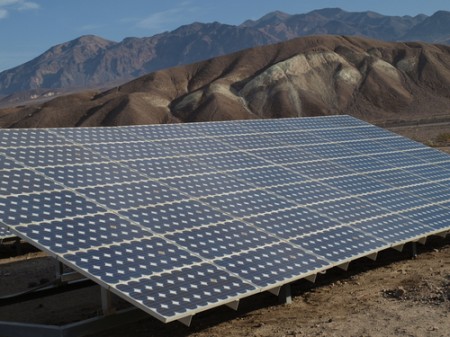By Johanna Wald, Natural Resources Defense Council
Secretary of Interior Department Ken Salazar this week is expected to announce an important milestone towards adopting a program for managing solar energy development on public lands in the West. The Department Interior and the Bureau of Land Management will publish a supplemental to their draft Solar Programmatic Environmental Impact Statement (PEIS), which was released for public comment in December 2010. For more than a year now, NRDC has been working closely with renewable industry representatives as well other environmental groups and Interior and BLM to achieve a balanced and environmentally responsible approach to solar development that we need to meet the challenge of climate change.
To NRDC, responsible renewable energy development means Interior needs to establish a program that is based on guiding solar development to appropriate places – places with high quality solar resources, low natural resource conflicts and the needed infrastructure in place or planned, rather than permitting solar projects – typically thousands of acres in size – to be strewn sporadically across our public lands.

Guiding development to appropriate areas or “solar zones” will clearly benefit the environment by minimizing development impacts. But it will also benefit the solar industry too. Identifying appropriate areas in advance will help minimize the controversies that have surrounded many of the first “fast track” solar projects Interior permitted on the public lands in the past year. By locating projects in less controversial areas, permitting and construction of projects will happen faster and developers’ ability to get financing for projects will be enhanced. Pre-identified zones will allow transmission planning for renewables to be more strategic and expedited, also reducing costs and impacts associated with such development. A zone-based approach will give developers more certainty for their projects and support the sustainable growth of the nascent solar industry. And most importantly, sustained growth of the solar industry and speedier construction of solar projects will enable us to mount a measurable and meaningful response to climate change.
Of course, identifying solar zones is not enough to build a comprehensive solar program. We need Interior and BLM to establish a program that balances the nation’s need for development of solar energy with the protection of the public lands and wildlife. Other key elements of such a program should include a process for adding new zones when the need arises and some limited flexibility to build projects outside of zones, including both new and pending proposals, given that the impacts of building outside pre-selected zones will be greater. But zones are absolutely key – they are the foundation for building a national program that’s “Smart from the Start.”
Solar generation at the utility-scale level represents a new paradigm for how this nation can generate electricity—all the more reason to establish a system that is based on lessons learned and that does not repeat the mistakes of the past that have allowed largely unrestricted development of fossil fuels on our public lands. We are at a unique crossroads for the management of public lands, in that we have the opportunity to create a program that prioritizes the siting of energy projects in appropriate areas, while also committing to minimize the impacts of these types of projects on our nation’s public lands. So that’s why after DOI releases its supplemental PEIS this week, the first thing we’ll be looking at in our review is what they say about zones. As Interior and BLM take this next step in building a balanced solar program, we are committed to continuing to work with both DOI and BLM, and the solar industry to make sure that this new solar program meets our shared goals for smart and efficient siting and permitting, protection of unique and sensitive natural resources, and getting renewable energy online faster to combat climate challenge and move forward with building a clean energy economy.
![]() Editor’s Note: This column comes to us as a cross post courtesy of Natural Resources Defense Council. Author credit for the column goes to Johanna Wald.
Editor’s Note: This column comes to us as a cross post courtesy of Natural Resources Defense Council. Author credit for the column goes to Johanna Wald.